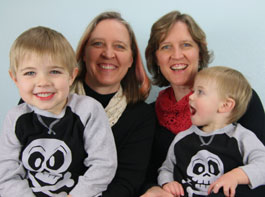How to Make an Abacus with Yarn – Great Craft for Kids
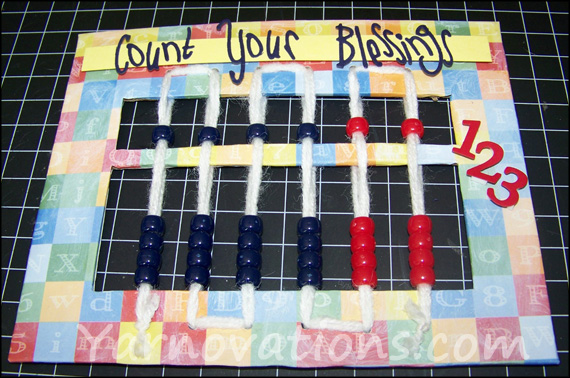 An abacus is a great way to make all kinds of calculations. Below we’ll show you how to make an abacus with yarn that’s perfect for kids of all ages. This arts and crafts project has two great math lessons – measurement and addition with an abacus. The colors on this abacus make it versatile. Teach numbers with two decimals such as currency or ignore the colors and teach whole numbers up to the 100,000’s.
An abacus is a great way to make all kinds of calculations. Below we’ll show you how to make an abacus with yarn that’s perfect for kids of all ages. This arts and crafts project has two great math lessons – measurement and addition with an abacus. The colors on this abacus make it versatile. Teach numbers with two decimals such as currency or ignore the colors and teach whole numbers up to the 100,000’s.
We’ve also decorated ours and given it the title, “Count your Blessings.” This abacus can now be used to teach a character building lesson on the value of thankfulness. Psalm 103 would be a great Bible passage to illustrate thankfulness.
Psalm 103:2 says, “Praise the Lord, my soul, and forget not all his benefits.”
How to Make an Abacus with Yarn – Features and Supplies List
Don’t let the simple style of this abacus fool you. This little abacus has a lot of great features:
- The four strands of yarn keep the beads in place allowing students to hold up their abaci to show their answers to their teacher.
- Teach numbers with two decimals or whole numbers to the 100,000’s.
- Many different lessons can be taught with this one project.
- Easy to make.
- Materials are minimal and cheap.
- It’s thin, small and light weight making it easy to carry and keep with one’s math book.
- It’s fun to make and use.
We mentioned that the supplies are minimal and cheap. Check around your house for the following:
- 30 Pony Beads (we used 20 blue and 10 red)
- cardboard 7 1/4″ x 5 1/4″
- yarn (4 pieces) 48″ length each
- whole punch (1/8″)
- box cutter/knife (use with caution! Supervise kids using these.)
- pencil
- standard ruler
- scissors
- yarn needle
- Supplies to decorate (we used paper, glue and tape)
How to Make an Abacus with Yarn – Lesson One: Working with Inches
If your kids need practice using a standard ruler, this is a great project (or you can trace and use this Abacus template).
- Start with a piece of cardboard that’s 7 1/4″ x 5 1/4″. (Mine is 1/2″ taller but required a special hole punch. If you are using a standard single hole punch, then you’ll want to cut your abacus to 7 1/4″ x 5 1/4″).
- With the long side of the cardboard horizontal in front of you, draw a vertical line at 1″, 1 3/4″, 2 1/2″, 3 1/4″, 4″, 4 3/4″, 5 1/2″, 6 1/4″. See image below.
- With the short side of the cardboard horizontal in front of you, draw a vertical line at 1/2″, 1″, 3″, 3 1/4″, 4 1/4″, 4 3/4″, 5 1/4″. See image below.
- Punch holes on the lines that are 1/2″ from the ends where they intersect the lines drawn in step 2. There will be 6 on each side (12 total). See image below.
- Cut out 2 rectangles leaving a thin horizontal bar in the middle. See image below.
- Cut 4 strands of yarn to 48″ each.
- Thread two pieces of yarn on your needle.
- Start at the bottom left corner, insert yarn into first hole leaving a tail about 5″ long. Thread 5 beads onto yarn. Weave round thin middle bar then weave up and through the hole at the top. (At this point the five beads can move in either section). See image below.
- Insert yarn into next hole. Thread 5 beads onto yarn. Again, weave around middle bar and weave to and through the hole on the bottom.
- Repeat step 9 until all 6 sets of beads have been stranded. Remove needle.
- Thread remaining two pieces of yarn on your needle.
- Weave this strand in the opposite direction as the first strands of yarn. Wherever you weaved on top of the cardboard, now weave on the bottom. Make sure you thread 4 beads into the bottom section and a single bead into the top section of all 6 sections. *The weaving is what will lock the beads into each section. See image below.
- Knot the tails of yarn and trim.
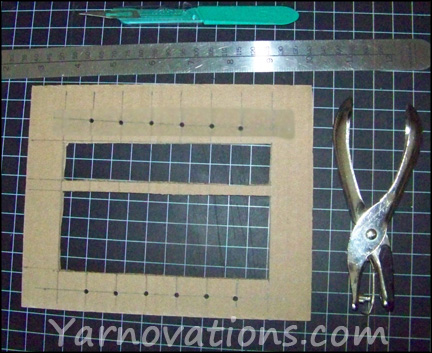
Draw lines, punch holes and cut out rectangles.
Decorate cardboard if desired. We glued decorative paper on the front and back.

This is what your abacus will look like after following steps 8-10.
At this point, the beads can float between the top and bottom section. The next step will lock them in their appropriate sections.
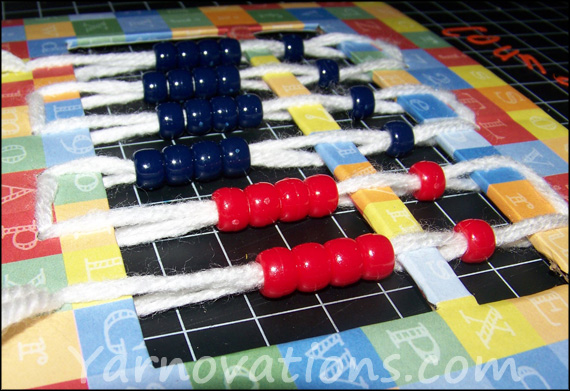
Beads become trapped when second strand is woven on the opposite side.
Decorate a bit more if desired. We added our title and some numbers to ours at this point. Now the abacus is ready to use!
How to Make an Abacus with Yarn – What Each Row Represents
Now that we’ve learned how to make an abacus, let’s take a look at what the different colors and columns of beads mean.
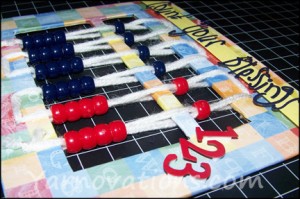
Side view of finished abacus
Using the Colors
If you attribute value to the colors, then the abacus has four whole numbers (the blue beads on the left) followed by two decimal places (the red on the right). From left to right you have: Thousands, Hundreds, Tens and Ones in blue. Then Tenths and Hundredths in red.
Ignoring the Colors
If you ignore the fact that the beads have color, then you have six columns of whole numbers. From right to left you have: Ones, Tens, Hundreds, Thousands, Ten Thousands, Hundred Thousands.
How to Make an Abacus with Yarn – How to Count and Add
We could write pages and pages of content on how to understand and add with an abacus. Instead, we recommend that you watch this great video tutorial.
Deborah’s (Yarnovator) 5th grade class thought these homemade abaci were amazing. Yes, the abacus is amazing. Yes, she’s a great teacher for giving them each their own abacus. Want to be your kids’ hero? Give it a try. Your kids are going to love them and they’ll think you’re amazing, too!

